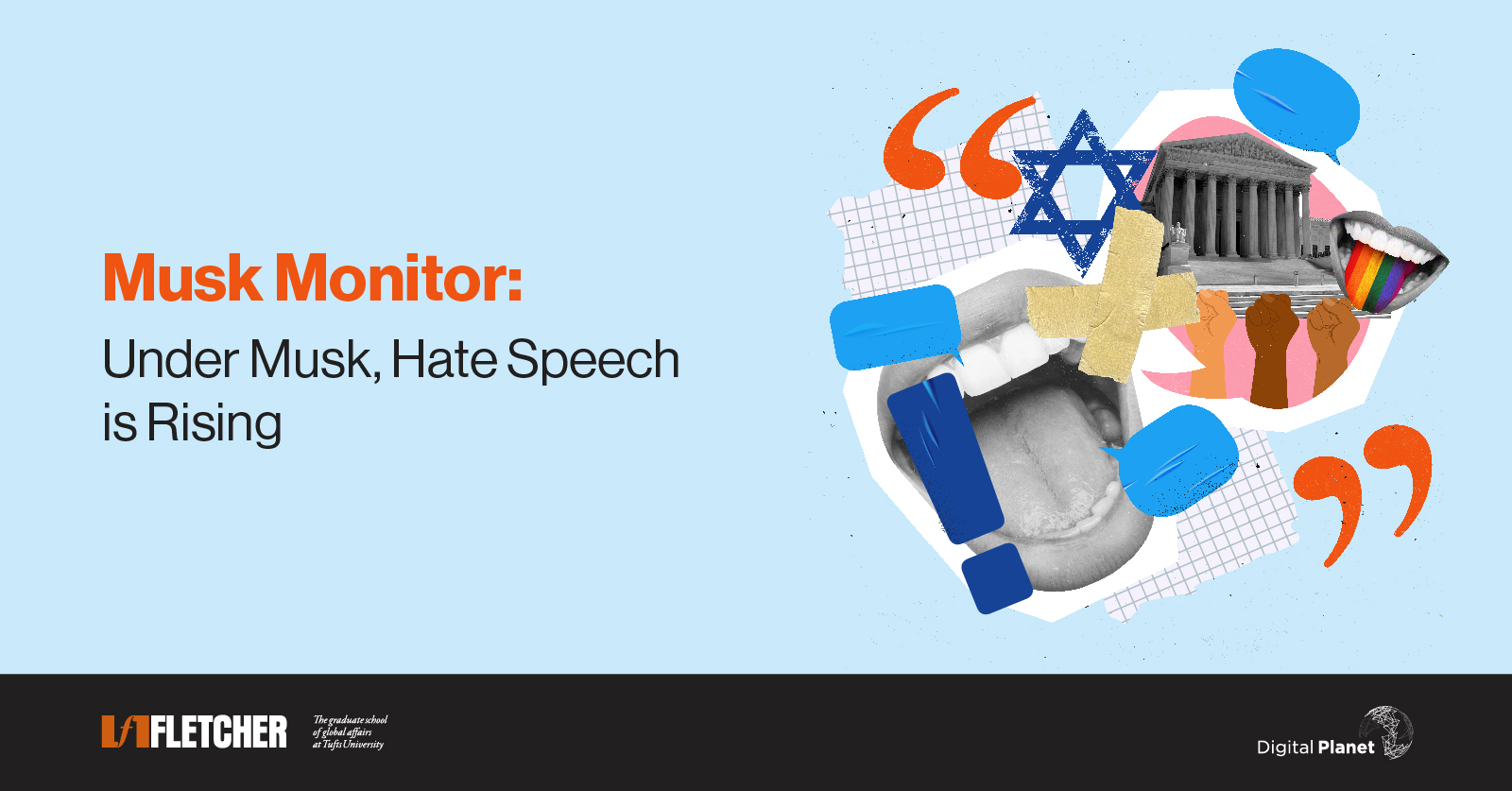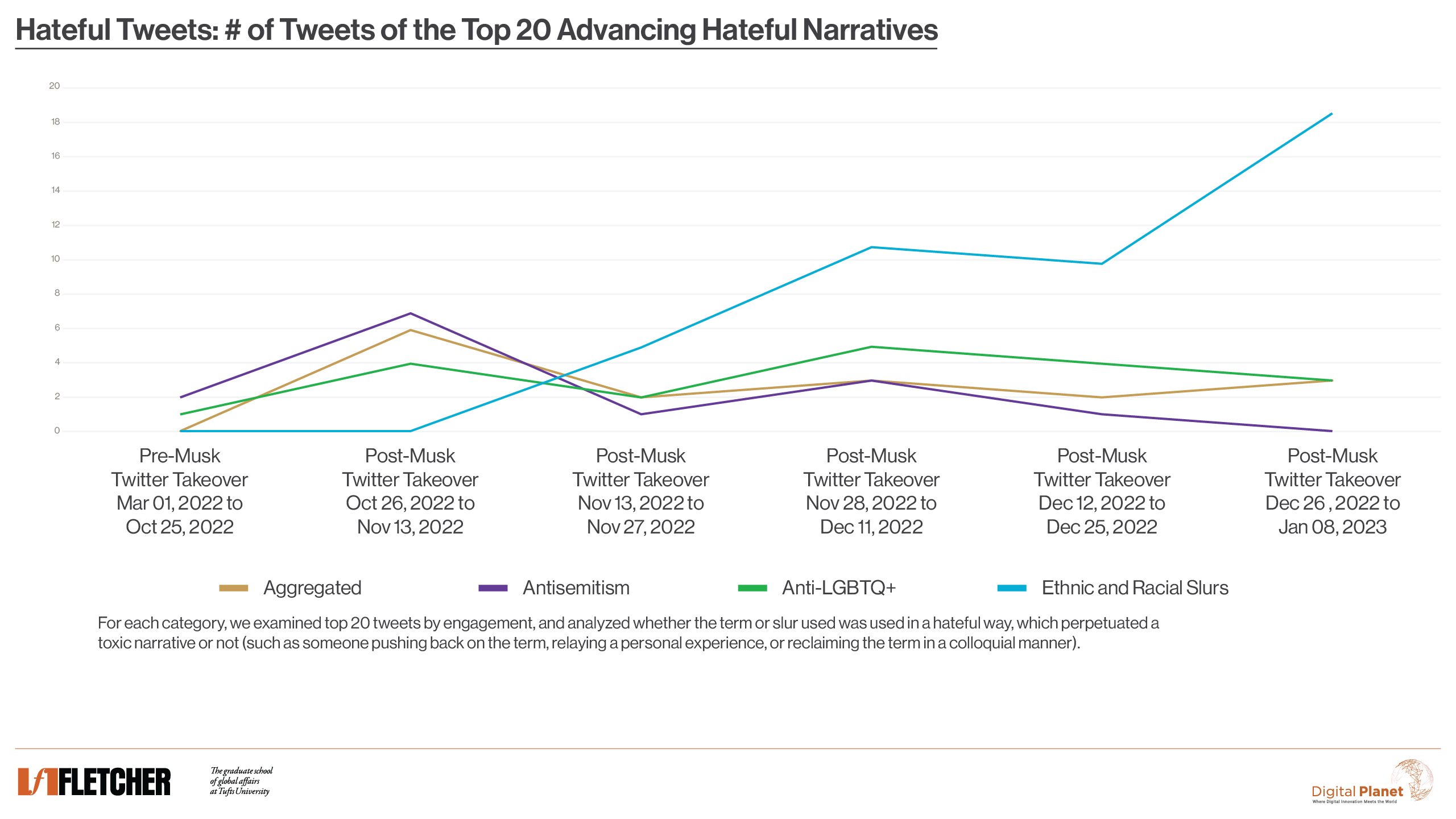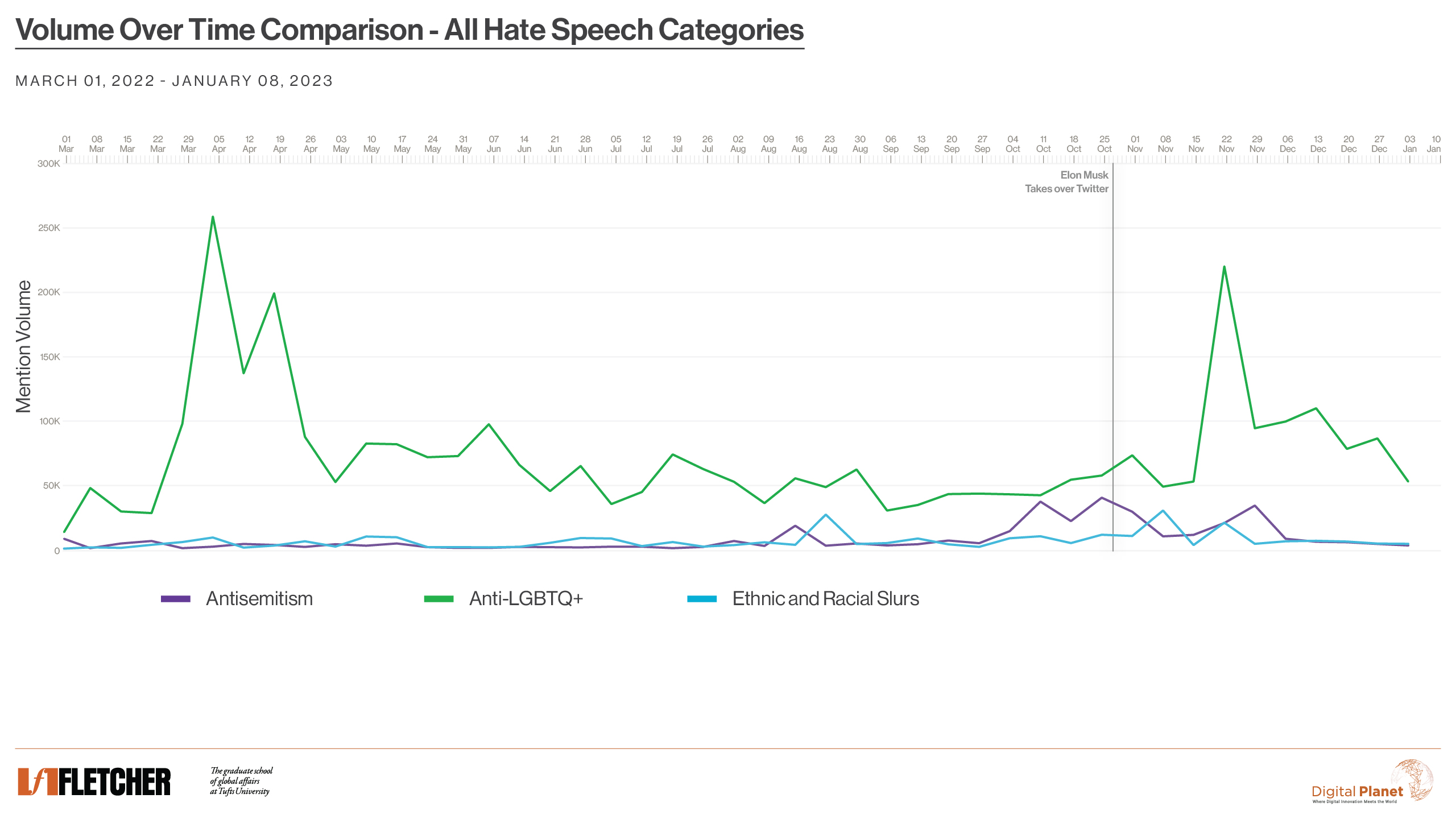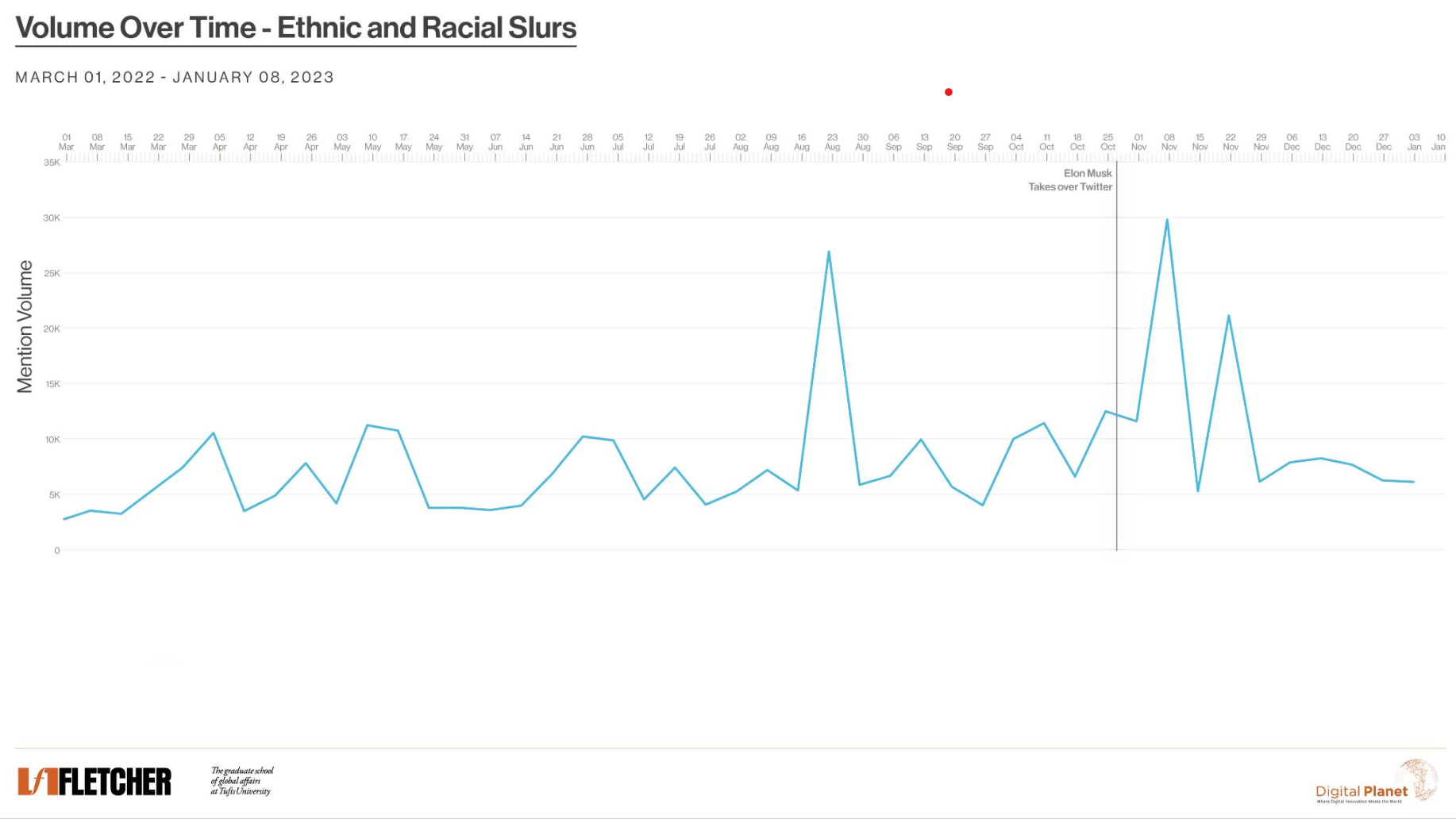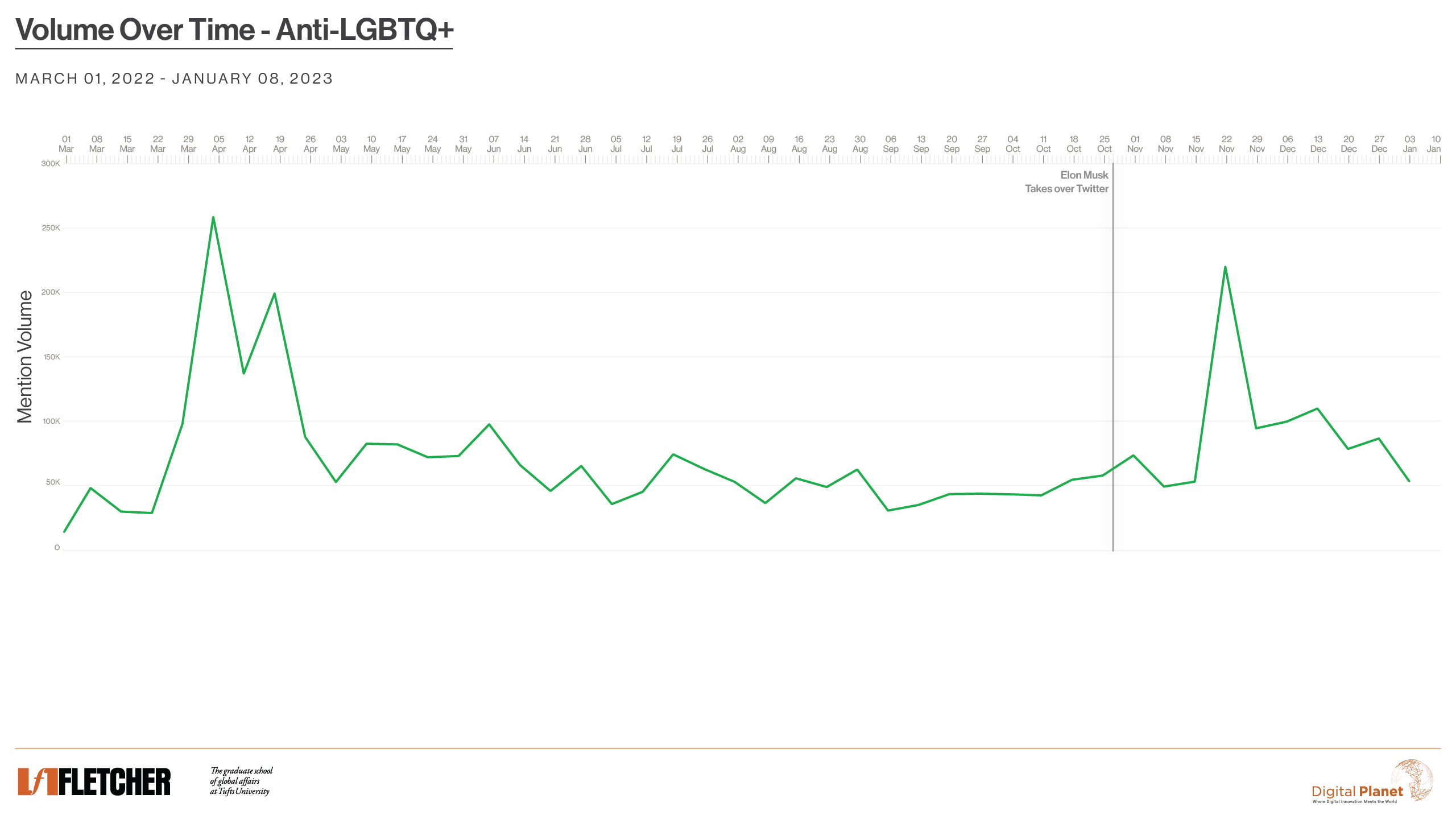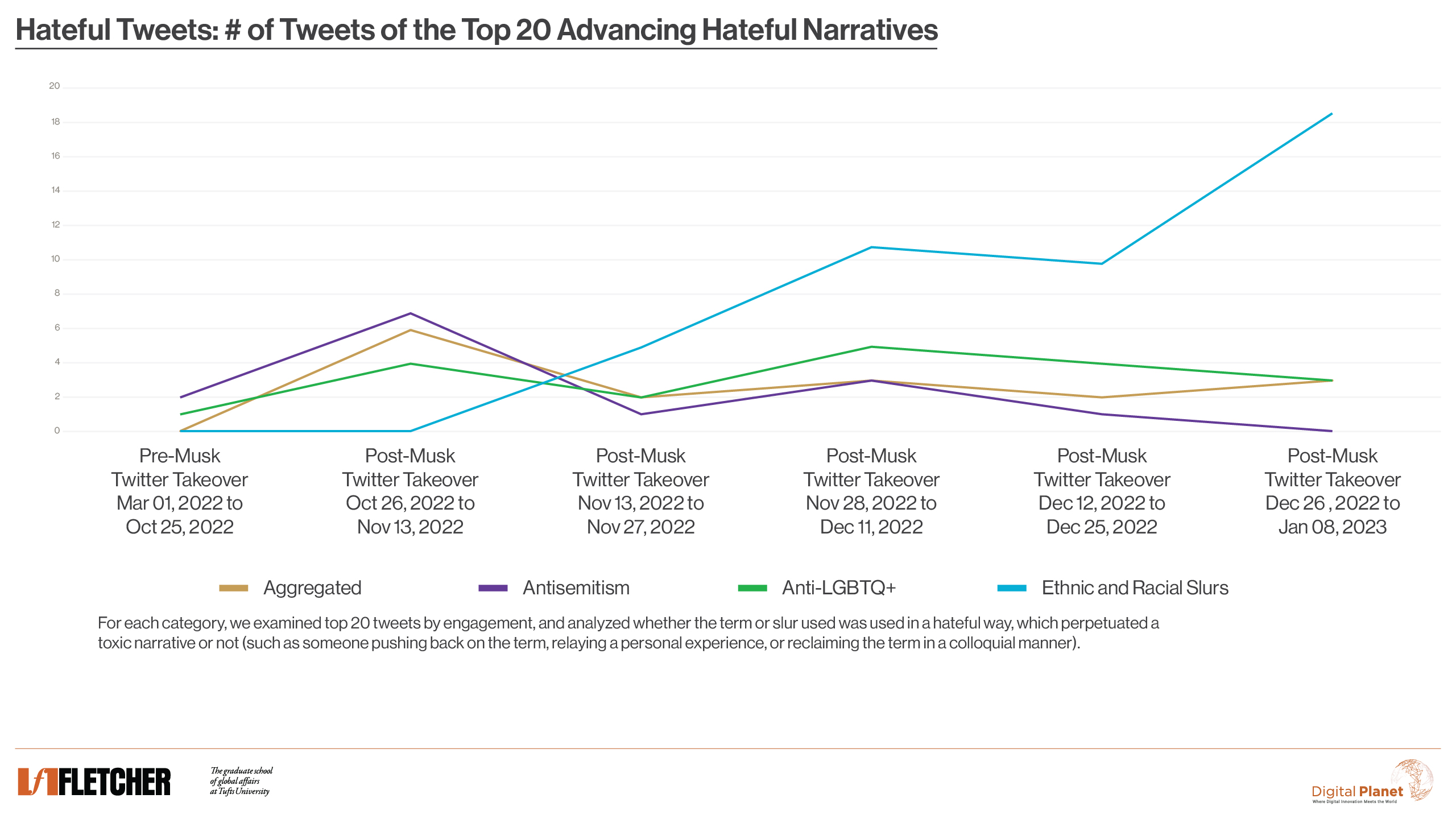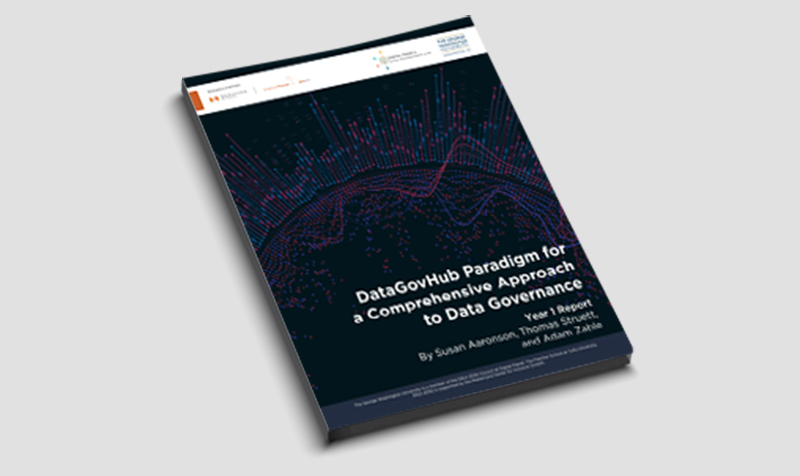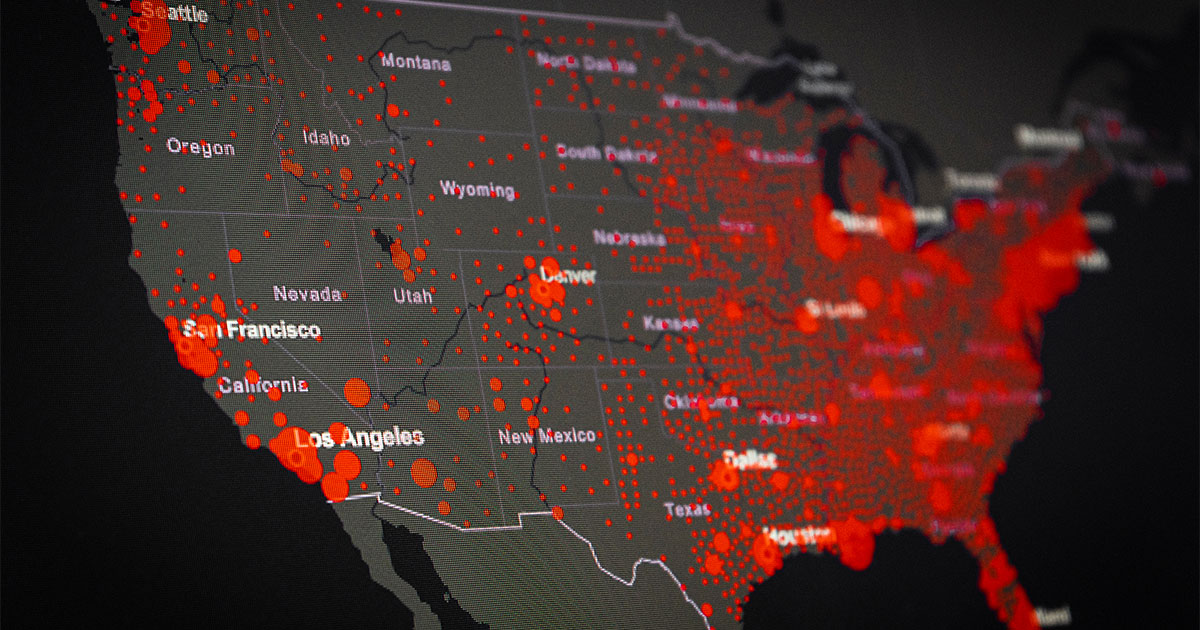Digital Planet > Digital Pulse >Musk Monitor: Under Musk, Hate Speech is Rising
Summary
Summary: Following the takeover of Twitter by Elon Musk, hate speech and toxic narratives have been trending in the weeks immediately after the takeover. For the following analysis, we focused on three hateful narratives: antisemitism, anti-LGBTQ+ rhetoric, and racial/ethnic hate speech. We compared the extent of their presence on a pre-Musk Twitter and a post-Musk Twitter. Our 10-month analysis (March 1, 2022-January 8, 2023) revealed two alarming findings: first, the volume of each of these hate speech narratives has increased, post Twitter’s takeover by Musk. Second, the quality of the conversation has deteriorated, with more of the conversations on Twitter advancing these hateful narratives, rather than combatting them. While there may be a slight change in the volume of hate speech after Elon Musk declared “New Twitter policy is freedom of speech, but not freedom of reach,” the change is small. Our toxicity count for Post Musk #2 (Nov 14 – Nov 27) shows a slight change, however, a running analysis will provide further evidence over a longer period. Nevertheless, it is clear that Musk’s Twitter is more toxic and remains so, compared to its older self.
Warning: The following content may be upsetting and/or traumatizing. This analysis discusses various forms of hate speech (antisemitism, anti-LGBTQ+, and racism) and allegations of child sexual abuse. We pull language directly from Twitter, much of which includes vile words, phrases, and narratives.
The Twitter saga has seen a lot of dramatic twists and turns after its new boss, Elon Musk took over on October 27. To name a few key changes—Musk fired key executives, including Vijaya Gadde (Chief Counsel), while Yoel Roth (Head of Trust and Safety) left shortly after the takeover. Pertinently, they were both key to leading content moderation on Twitter. In parallel, over 50% (and counting) of staff and 80% of the contract workforce was let go, with very few foot soldiers left to man the gates of misinformation. This resulted in users and groups testing the boundaries to see if hateful words and slurs would make it past the filters. While several key users whose followers were adding to the volume of hate speech were let back in, advertisers were starting to flee. In the midst of all of this self-created turmoil, Musk tweeted a chart claiming a reduction in hate speech without any substantiation. He then tweeted “New Twitter policy is freedom of speech, but not freedom of reach. Negative/hate tweets will be max deboosted & demonetized, so no ads or other revenue to Twitter… .” If this is the new policy memo – a post-Musk Twitter doesn’t seem to have received it, as hate speech narratives have been on the rise since his takeover.
Brief Methodology
Data has been analyzed over six periods: (1) Pre-Musk (March 1 to October 25), (2) Post-Musk #1 (October 26 to November 13), (3) Post-Musk #2 (November 14 – November 27), (4) Post-Musk #3 (November 28 to December 11), (5) Post-Musk #4 (December 12 to December 25) and (6) Post-Musk #5 (December 26 to January 8, 2023). The data analyzed is the top 20 tweets (on basis of volume of retweets) of each of these narratives. If a tweet is not recognized as toxic for the purposes of this analysis, it only means that it is not toxic in the context of being antisemitic, anti-LGBTQ+ or ethnic hate speech. It does not eliminate the possibility of the tweet being toxic under a different narrative (for e.g., a tweet may qualify as a politically toxic narrative in the context of ‘pedophilia or grooming’ but may not be marked as toxic here if it doesn’t fall under the umbrella of an anti-LGBTQ+ hate speech narrative/ tweet.). The full methodology is found at the end of this report.
Timeline highlights
- October 26, 2022: Elon Musk walks into Twitter HQ with a sink, tweeting “Entering Twitter HQ – let that sink in!”
- October 27, 2022: Elon Musk officially takes over Twitter.
- October 30, 2022: Musk announces a revamp of Twitter’s verification process.
- November 4, 2022: Musk announces layoffs of 3,700 employees.
- November 12, 2022: Musk fires 80% of contract employees.
- November 18, 2022: Musk introduced the new Twitter policy “New Twitter policy is freedom of speech, but not freedom of reach. Negative/hate tweets will be max deboosted & demonetized, so no ads or other revenue to Twitter…”
- November 23, 2022: Musk proposes general amnesty to suspended Twitter accounts.
- November 23, 2022: Musk tweets “Hate speech impressions down by 1/3 from pre-spike levels. Congrats to Twitter team!”
- November 24, 2022: Musk announces general amnesty to suspended Twitter accounts, prompting concerns over “superspreaders” of hate returning to the platform.
- December 2, 2022: First “Twitter Files” thread is posted. Musk shared internal Twitter documents with a select group of journalists, requiring that they release their findings on Twitter. Conservatives claim that the “Twitter Files” show clear evidence that right-wing accounts were blacklisted or shadowbanned. Analysts and reporters are claiming that the release lacks crucial context.
- December 12, 2022: Former head of Trust and Safety, Yoel Roth, is forced to leave his home due to violent threats following the release of the “Twitter Files.”
Twitter has shown a grisly side of several toxic political and hate speech narratives in the past year. Elon Musk’s vision for what a post-Musk Twitter would be, as communicated by him to Twitter advertisers, was “…Twitter obviously cannot become a free-for-all hellscape, where anything can be said with no consequences!…”. However, the post-Musk Twitter trends analyzed hereinafter suggest otherwise. While pre-Musk Twitter was not free of toxic narratives, the conversations around these tweets were seen to be combatted by the platform and its users. However, post-takeover, we noticed an immediate shift in paradigm where Twitter users boldly tested the boundaries of the platform under Musk. From the data given below, it doesn’t look like these trends have died down, despite Musk’s claims of hate speech reducing on Twitter.
To assess this paradigm shift, we analyzed the tweets (and comments) on these hate speech narratives over six periods: (1) Pre-Musk (March 1 to October 25), (2) Post-Musk #1 (October 26 to November 13), (3) Post-Musk #2 (November 14 – November 27), (4) Post-Musk #3 (November 28 to December 11), (5) Post-Musk #4 (December 12 to December 25) and (6) Post-Musk #5 (December 26 to January 8, 2023).
Key Findings
Our findings below have been looked at from a dual lens—(1) overall mentions of hateful slurs—to first understand the sheer change in volume; and (2) more importantly—then indexing the rise in hate narratives to better differentiate between use of slurs for hateful purposes vs. their use for pushback against hate, ironic purposes, or users “reclaiming” a hateful term. In other words, identifying where the use of these words and phrases are used in a hateful manner. It is notable that among the top 20 tweets in all periods, the majority of the tweets using these terms were not using them in a hateful or toxic manner. In other words, and as also clarified by Twitter Safety, context matters. This underscores the importance of contextualizing the tweets, not simply relying on the overall volume of mentions of these terms.
In a nutshell, there appears to have been a change in almost all post-Musk windows, relative to the post-Musk #1 window. In some categories the numbers are down. The overall conclusion, however, still holds: hate speech continues to be noticeably higher in the post-Musk than pre-Musk.
1. Twitter has seen an increase in antisemitic, ethnic hate speech and anti-LGBTQ+ mention volume from the pre-Musk period to the post-Musk period
The antisemitic mentions in the pre-Musk period were a mention volume of 19,343 tweets in the week of August 15, 36,840 mentions in the week of October 10, 39,700 mentions in the week of October 24 (October 27 is when Musk announced his takeover of Twitter). A look at the top 20 pre-Musk tweets (at point 3 below) indicates that the highest peaks during the weeks of October 10 and October 24 were users protesting the inaction against antisemitism and Kanye West’s antisemitic tweets. The post-Musk period saw 29,427 mentions in the week of October 31(52% increase from pre-Musk peak) and 21,224 mentions in the week of November 21 (9.7% increase from pre-Musk peak). The sudden change for the worse, in antisemitic hate speech, is analysed below.
The highest weekly ethnic hate speech mentions in the pre-Musk period have been a mention volume of 26,807 tweets in the week of August 22. However, towards the end of October, the ethnic hate speech tweets have seen massive mention volume with count reaching 29,695 mentions in the week of November 7 (10.77% increase since pre-Musk peak of August 22 week) and 21,092 mentions in the week of November 21.
The highest weekly ethnic hate speech mentions in the pre-Musk period have been a mention volume of 257,627 tweets in the week of April 4 and 198,827 in the week of April 18. The week of November 21 saw a spike in recorded mention volumes of 219,329. The spike in April, however, doesn’t appear to be on account of hate speech but mention of terms that also constitute hate speech (as can be contextualized from the tweets set out at Pre-Musk top 20 tweets below).
2. Twitter has seen an increase in anti-LGBTQ+ tweets, slurs and sexual references












Note: all toxic tweets are marked red.
There is one toxic tweet out of the top 20 tweets in the pre-Musk period. The trend in the top 20 Pre-Musk period tweets either shows the word ‘Groomers’ being used in a cautionary context or to bust myths of what constitutes ‘grooming’, or stating news of related offences.
The Post-Musk period, however, sees a total of 6 toxic tweets out of the top 20 tweets. These are mainly users testing the boundaries of twitter and its new policy by using anti-LGBTQ+ slurs – repeatedly using slurs such as f****t (homophobic slurs), the ‘N’ word, ‘commie groomers’ etc. The comments to these tweets see – reciprocation through violence being suggested, jokes being built on the narrative set out by the tweet, accusations being made against different cultures for propagating ‘grooming’ and ‘sexualization’ of children etc.
3. Twitter has seen an increase in antisemitic slurs and sentiments












There are 2 toxic tweets out of the top 20 tweets in the pre-Musk period. The trend in the top 20 pre-Musk period tweets is mostly pushback aimed at public figures / persons that support either antisemitic views or people with antisemitic views.
The post-Musk period, however, sees a total of 8 toxic tweets out of the top 20 tweets. There is an increase in the use of slurs and strong antisemitic sentiments being expressed. There is also unfettered support for celebrities / people that have made expressed their antisemitic views. These trends are also noticed in the comments section, with very little retaliation or protest against the use of such slurs / expression of antisemitic views.
4. Increase in discussions regarding "#antiwhite" (white people claiming they are a target of racism) trends in Post-Musk Twitter












There are 0 toxic tweets out of the top 20 tweets in the pre-Musk period.
The post-Musk period, however, sees a total of 5 toxic tweets out of the top 20 tweets, mainly advancing the popular narrative around white nationalists, of how ‘white’ people are the target of racism and the expression of views in the comments section is largely accusatory.
The above analysis also compels us to scrutinize Musk’s use of “impressions” as a solo measure to calculate the reduction in hate speech, as it doesn’t seem to give a complete picture of what is truly unfolding on Twitter as a platform.
To dig into the data and analysis, view our interactive report below:
Methodology
We use specialized technology and algorithms to access and analyze large amounts of open-source data. For this analysis, we have assembled a dataset of 3.9 million Tweets, between March 01, 2022 and November 27, 2022, covering three categories of hate speech on Twitter in the United States i.e., antisemitic hate speech, anti-LGBTQ+ hate speech, and ethnic and racial hate speech.
Further, to understand whether the amount of hate speech or the toxicity level on Twitter changed (increased, decreased, or remained the same) since Elon Musk took control of Twitter, we identified the top 20 most popular Tweets based on the total number of retweets across the three hate speech categories and across specific time intervals.
- The first time period, covers roughly eight months prior to Musk’s ownership of Twitter from March 01, 2022 to October 25, 2022.
- The second time period, post-Elon Musk’s takeover, covers October 26, 2022 and November 27, 2022.
- To add further granularity, the time period of analysis post Elon Musk’s takeover is further broken down by two weeks intervals i.e., October 26, 2022 to November 13, 2022 and November 14, 2022 to November 27, 2022.
Toxic Tweets from the list of top 20 Tweets across the hate speech categories and time periods are then manually picked and flagged by our experts. We have cleaned up the dataset to exclude spam tweets and other irrelevant topics if any.
Data Limitations
Given the high volume of posts and length of the timeline, we cannot collect, measure, and analyze every single tweet related to this topic. Our access to the Twitter API algorithmically downsamples the data collected, but the overall trend and patterns are consistent with the full sample.
We will continue to follow these narratives around hate speech.
Watch this space for updates. Share your thoughts with us on—for the time being—Twitter: @dgtl_planet
Digital Pulse, an initiative of Digital Planet, is a platform for measuring and understanding evolving sentiments and responses, expressed online by people around the world, to breaking events globally by harnessing unstructured data.
For this piece, the gathering and preliminary analysis of unstructured data was conducted by Ripple Research, a Digital Planet affiliate, under the direction and guidance of Bhaskar Chakravorti and Christina Filipovic. Final analysis and writing by Digital Planet. Special thanks to Elena Latzen and Mitakshi Lakhani for their contributions and additional analysis.


